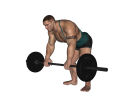 Anterior Raise - Barbell Straight Grip
Anterior Raise - Barbell Straight Grip
Benefits: This exercise isolates the anterior delt muscle as well as the posterior delt muscle
Purpose: This exercise strengthens the front and rear deltoid muscle areas.
Beginner Anterior Delts Posterior Delts Strength Barbell Pull Gym
General Info: The anterior (front) deltoid or shoulder is one of the three distinct heads of the deltoid anatomy. It raises the arm toward the front and rotates the arm inward.
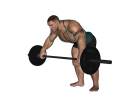 Anterior Raise - Barbell Wide Grip
Anterior Raise - Barbell Wide Grip
Benefits: This exercise isolates the anterior delt muscle as well as the posterior delt muscle
Purpose: This exercise strengthens the front and rear deltoid muscle areas.
Beginner Anterior Delts Posterior Delts Strength Barbell Pull Gym
General Info: The anterior (front) deltoid or shoulder is one of the three distinct heads of the deltoid anatomy. It raises the arm toward the front and rotates the arm inward.
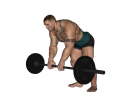 Anterior Raise - Bent Over Barbell
Anterior Raise - Bent Over Barbell
Benefits: This exercise isolates the anterior delt muscle as well as the posterior delt muscle
Purpose: This exercise strengthens the front and rear deltoid muscle areas.
Beginner Anterior Delts Posterior Delts Strength Barbell Pull Gym
General Info: The anterior (front) deltoid or shoulder is one of the three distinct heads of the deltoid anatomy. It raises the arm toward the front and rotates the arm inward.
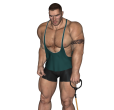 Anterior Raise - Cable
Anterior Raise - Cable
Benefits: This exercise isolates the anterior delt muscle. The use of a cable keeps tension on the muscle groups throughout the range of movement.
Purpose: This exercise strengthens the front deltoid muscle area.
Beginner Anterior Delts Traps Strength Cable Machine Pull Gym
General Info: The anterior (front) deltoid or shoulder is one of the three distinct heads of the deltoid anatomy. It raises the arm toward the front and rotates the arm inward.
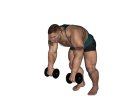 Anterior Raise - Dumbbell
Anterior Raise - Dumbbell
Benefits: This exercise isolates the anterior deltoid muscle as well as the posterior deltoid muscle. Rotating the thumb side of the hands downwards also improves the inward rotation motion of the shoulders.
Purpose: This exercise strengthens the front and rear deltoid muscle areas.
Beginner Anterior Delts Posterior Delts Strength Dumbbell Pull Gym
General Info: The anterior (front) deltoid or shoulder is one of the three distinct heads of the deltoid anatomy. It raises the arm toward the front and rotates the arm inward.
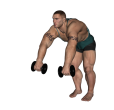 Anterior Raise - Dumbbell Alternate
Anterior Raise - Dumbbell Alternate
Benefits: This exercise isolates the anterior delt muscle as well as the posterior delt muscle. Performing the exercise suing one side then the other will help you focus the exercise.
Purpose: This exercise strengthens the front and rear deltoid muscle areas.
Beginner Anterior Delts Posterior Delts Strength Dumbbell Pull Gym
General Info: The anterior (front) deltoid or shoulder is one of the three distinct heads of the deltoid anatomy. It raises the arm toward the front and rotates the arm inward.
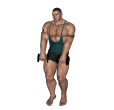 Anterior Raise - Dumbbell Alternate Narrow Stance
Anterior Raise - Dumbbell Alternate Narrow Stance
Benefits: This exercise isolates the anterior delt muscle. The narrow stance will require the use of stabilizer muscles. Alternating the exercise from one side to the other will help you focus on the specific muscles.
Purpose: This exercise strengthens the front deltoid muscle area.
Beginner Anterior Delts Traps Strength Dumbbell Pull Gym
General Info: The anterior (front) deltoid or shoulder is one of the three distinct heads of the deltoid anatomy. It raises the arm toward the front and rotates the arm inward.
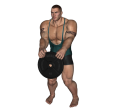 Anterior Raise - Plate
Anterior Raise - Plate
Benefits: This exercise isolates the anterior delt muscle as well as the posterior delt muscle.
Purpose: This exercise strengthens the front and rear deltoid muscle areas.
Beginner Anterior Delts Posterior Delts Strength Plate Pull Gym
General Info: The anterior (front) deltoid or shoulder is one of the three distinct heads of the deltoid anatomy. It raises the arm toward the front and rotates the arm inward.
 Anterior Raise - Water Bottle
Anterior Raise - Water Bottle
Benefits: This exercise isolates the anterior delt muscle as well as the posterior delt muscle.
Purpose: This exercise strengthens the front and rear deltoid muscle areas.
Beginner Anterior Delts Posterior Delts Strength Water Bottle Pull Home
General Info: The anterior (front) deltoid or shoulder is one of the three distinct heads of the deltoid anatomy. It raises the arm toward the front and rotates the arm inward.
 Anterior Raise - Water Bottle Alternate
Anterior Raise - Water Bottle Alternate
Benefits: This exercise isolates the anterior delt muscle as well as the posterior delt muscle.
Purpose: This exercise strengthens the front and rear deltoid muscle areas.
Beginner Anterior Delts Posterior Delts Strength Water Bottle Pull Home
General Info: The anterior (front) deltoid or shoulder is one of the three distinct heads of the deltoid anatomy. It raises the arm toward the front and rotates the arm inward.
 Anterior Raise - Water Bottle Single
Anterior Raise - Water Bottle Single
Benefits: This exercise isolates the anterior delt muscle as well as the posterior delt muscle.
Purpose: This exercise strengthens the front and rear deltoid muscle areas.
Beginner Anterior Delts Posterior Delts Strength Water Bottle Pull Home
General Info: The anterior (front) deltoid or shoulder is one of the three distinct heads of the deltoid anatomy. It raises the arm toward the front and rotates the arm inward.
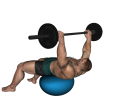 Barbell Press - Fitness Ball
Barbell Press - Fitness Ball
Benefits: A barbell allows someone to lift heavier weights and thus build more strength quicker.
Purpose: This exercise increases strength and strength speed, and produces greater functional strength for pressing movements.
Beginner Chest Triceps Anterior Delts Strength Barbell Fitness Ball Push Compound Gym
General Info: The chest is composed of the Pectoralis Major and the Pectoralis Minor. The Pec Major attaches to the upper arm and pulls the upper arm across the chest. The Pec Minor lies mostly underneath the Pec Major and draws the shoulder blade down and forward.
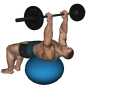 Barbell Press - Fitness Ball Guillotine
Barbell Press - Fitness Ball Guillotine
Benefits: A barbell allows someone to lift heavier weights and thus build more strength quicker.
Purpose: This exercise increases strength and strength speed, and produces greater functional strength for pressing movements.
Beginner Chest Triceps Anterior Delts Strength Barbell Fitness Ball Push Compound Gym
General Info: The chest is composed of the Pectoralis Major and the Pectoralis Minor. The Pec Major attaches to the upper arm and pulls the upper arm across the chest. The Pec Minor lies mostly underneath the Pec Major and draws the shoulder blade down and forward.
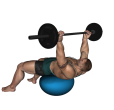 Barbell Press - Fitness Ball Reverse
Barbell Press - Fitness Ball Reverse
Benefits: A barbell allows someone to lift heavier weights and thus build more strength quicker.
Purpose: This exercise increases strength and strength speed, and produces greater functional strength for pressing movements.
Beginner Chest Triceps Anterior Delts Strength Barbell Fitness Ball Push Compound Gym
General Info: The chest is composed of the Pectoralis Major and the Pectoralis Minor. The Pec Major attaches to the upper arm and pulls the upper arm across the chest. The Pec Minor lies mostly underneath the Pec Major and draws the shoulder blade down and forward.
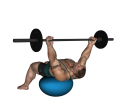 Barbell Press - Fitness Ball Reverse Wide
Barbell Press - Fitness Ball Reverse Wide
Benefits: A barbell allows someone to lift heavier weights and thus build more strength quicker.
Purpose: This exercise increases strength and strength speed, and produces greater functional strength for pressing movements.
Beginner Chest Triceps Anterior Delts Strength Barbell Fitness Ball Push Compound Gym
General Info: The chest is composed of the Pectoralis Major and the Pectoralis Minor. The Pec Major attaches to the upper arm and pulls the upper arm across the chest. The Pec Minor lies mostly underneath the Pec Major and draws the shoulder blade down and forward.
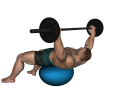 Barbell Press - Fitness Ball Wide Grip
Barbell Press - Fitness Ball Wide Grip
Benefits: A barbell allows someone to lift heavier weights and thus build more strength quicker.
Purpose: This exercise increases strength and strength speed, and produces greater functional strength for pressing movements.
Beginner Chest Triceps Anterior Delts Strength Barbell Fitness Ball Push Compound Gym
General Info: The chest is composed of the Pectoralis Major and the Pectoralis Minor. The Pec Major attaches to the upper arm and pulls the upper arm across the chest. The Pec Minor lies mostly underneath the Pec Major and draws the shoulder blade down and forward.
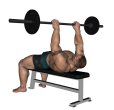 Barbell Press - Flat Bench
Barbell Press - Flat Bench
Benefits: This is the basic chest exercise.
Purpose: Benefits A barbell allows someone to lift heavier weights and thus build more strength quicker.
Beginner Chest Triceps Anterior Delts Strength Barbell Flat Bench Push Compound Gym
General Info: The chest is composed of the Pectoralis Major and the Pectoralis Minor. The Pec Major attaches to the upper arm and pulls the upper arm across the chest. The Pec Minor lies mostly underneath the Pec Major and draws the shoulder blade down and forward.
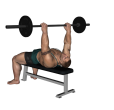 Barbell Press - Flat Bench and Flye
Barbell Press - Flat Bench and Flye
Benefits: A barbell allows someone to lift heavier weights and thus build more strength quicker.
Purpose: This exercise increases strength and strength speed, and produces greater functional strength for pressing movements.
Intermediate Chest Triceps Anterior Delts Strength Barbell Flat Bench Push Compound Gym
General Info: The chest is composed of the Pectoralis Major and the Pectoralis Minor. The Pec Major attaches to the upper arm and pulls the upper arm across the chest. The Pec Minor lies mostly underneath the Pec Major and draws the shoulder blade down and forward.
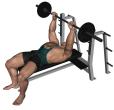 Barbell Press - Flat Bench Guillotine
Barbell Press - Flat Bench Guillotine
Benefits: A barbell allows someone to lift heavier weights and thus build more strength quicker.
Purpose: This exercise increases strength and strength speed, and produces greater functional strength for pressing movements.
Beginner Chest Triceps Anterior Delts Strength Barbell Flat Bench Push Compound Gym
General Info: The chest is composed of the Pectoralis Major and the Pectoralis Minor. The Pec Major attaches to the upper arm and pulls the upper arm across the chest. The Pec Minor lies mostly underneath the Pec Major and draws the shoulder blade down and forward.
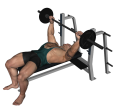 Barbell Press - Flat Bench Guillotine Wide Grip
Barbell Press - Flat Bench Guillotine Wide Grip
Benefits: A barbell allows someone to lift heavier weights and thus build more strength quicker.
Purpose: This exercise increases strength and strength speed, and produces greater functional strength for pressing movements.
Beginner Chest Triceps Anterior Delts Strength Barbell Flat Bench Push Compound Gym
General Info: The chest is composed of the Pectoralis Major and the Pectoralis Minor. The Pec Major attaches to the upper arm and pulls the upper arm across the chest. The Pec Minor lies mostly underneath the Pec Major and draws the shoulder blade down and forward.
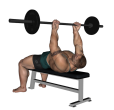 Barbell Press - Flat Bench Reverse
Barbell Press - Flat Bench Reverse
Benefits: A barbell allows someone to lift heavier weights and thus build more strength quicker. The reverse grip makes the exercise more difficult.
Purpose: This exercise increases strength and strength speed, and produces greater functional strength for pressing movements.
Beginner Chest Triceps Anterior Delts Strength Barbell Flat Bench Push Compound Gym
General Info: The chest is composed of the Pectoralis Major and the Pectoralis Minor. The Pec Major attaches to the upper arm and pulls the upper arm across the chest. The Pec Minor lies mostly underneath the Pec Major and draws the shoulder blade down and forward.
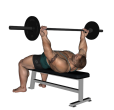 Barbell Press - Flat Bench Reverse Wide
Barbell Press - Flat Bench Reverse Wide
Benefits: A barbell allows someone to lift heavier weights and thus build more strength quicker. The reverse grip makes the exercise more difficult.
Purpose: This exercise increases strength and strength speed, and produces greater functional strength for pressing movements.
Beginner Chest Triceps Anterior Delts Strength Barbell Flat Bench Push Compound Gym
General Info: The chest is composed of the Pectoralis Major and the Pectoralis Minor. The Pec Major attaches to the upper arm and pulls the upper arm across the chest. The Pec Minor lies mostly underneath the Pec Major and draws the shoulder blade down and forward.
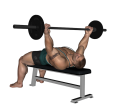 Barbell Press - Flat Bench Reverse Wide Feet Up
Barbell Press - Flat Bench Reverse Wide Feet Up
Benefits: A barbell allows someone to lift heavier weights and thus build more strength quicker.
Purpose: This exercise increases strength and strength speed, and produces greater functional strength for pressing movements.
Beginner Chest Triceps Anterior Delts Strength Barbell Flat Bench Push Compound Gym
General Info: The chest is composed of the Pectoralis Major and the Pectoralis Minor. The Pec Major attaches to the upper arm and pulls the upper arm across the chest. The Pec Minor lies mostly underneath the Pec Major and draws the shoulder blade down and forward.
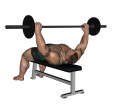 Barbell Press - Flat Bench Wide Grip
Barbell Press - Flat Bench Wide Grip
Benefits: A barbell allows someone to lift heavier weights and thus build more strength quicker.
Purpose: This exercise increases strength and strength speed, and produces greater functional strength for pressing movements.
Beginner Chest Triceps Anterior Delts Strength Barbell Flat Bench Push Compound Gym
General Info: The chest is composed of the Pectoralis Major and the Pectoralis Minor. The Pec Major attaches to the upper arm and pulls the upper arm across the chest. The Pec Minor lies mostly underneath the Pec Major and draws the shoulder blade down and forward.
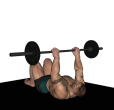 Barbell Press - Floor
Barbell Press - Floor
Benefits: A barbell allows someone to lift heavier weights and thus build more strength quicker.
Purpose: This exercise increases strength and strength speed, and produces greater functional strength for pressing movements.
Beginner Chest Triceps Anterior Delts Strength Barbell Push Compound Gym
General Info: The chest is composed of the Pectoralis Major and the Pectoralis Minor. The Pec Major attaches to the upper arm and pulls the upper arm across the chest. The Pec Minor lies mostly underneath the Pec Major and draws the shoulder blade down and forward.
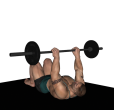 Barbell Press - Floor and Flye
Barbell Press - Floor and Flye
Benefits: A barbell allows someone to lift heavier weights and thus build more strength quicker. While this is primarily a chest movement, it also works the anterior deltoids.
Purpose: This exercise increases strength and strength speed, and produces greater functional strength for pressing movements.
Intermediate Chest Triceps Anterior Delts Strength Barbell Push Compound Gym
General Info: The chest is composed of the Pectoralis Major and the Pectoralis Minor. The Pec Major attaches to the upper arm and pulls the upper arm across the chest. The Pec Minor lies mostly underneath the Pec Major and draws the shoulder blade down and forward.
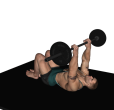 Barbell Press - Floor Guillotine
Barbell Press - Floor Guillotine
Benefits: A barbell allows someone to lift heavier weights and thus build more strength quicker.
Purpose: This exercise increases strength and strength speed, and produces greater functional strength for pressing movements.
Beginner Chest Triceps Anterior Delts Strength Barbell Push Compound Gym
General Info: The chest is composed of the Pectoralis Major and the Pectoralis Minor. The Pec Major attaches to the upper arm and pulls the upper arm across the chest. The Pec Minor lies mostly underneath the Pec Major and draws the shoulder blade down and forward.
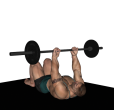 Barbell Press - Floor Reverse
Barbell Press - Floor Reverse
Benefits: A barbell allows someone to lift heavier weights and thus build more strength quicker. The reverse grip makes the exercise more difficult.
Purpose: This exercise increases strength and strength speed, and produces greater functional strength for pressing movements.
Beginner Chest Triceps Anterior Delts Strength Barbell Push Compound Gym
General Info: The chest is composed of the Pectoralis Major and the Pectoralis Minor. The Pec Major attaches to the upper arm and pulls the upper arm across the chest. The Pec Minor lies mostly underneath the Pec Major and draws the shoulder blade down and forward.
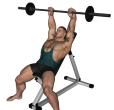 Barbell Press - Incline and Flye
Barbell Press - Incline and Flye
Benefits: A barbell allows someone to lift heavier weights and thus build more strength quicker. While this is primarily a chest movement, it also works the anterior deltoids.
Purpose: This exercise increases strength and strength speed, and produces greater functional strength for pressing movements.
Intermediate Chest Triceps Anterior Delts Strength Barbell Incline Bench Push Compound Gym
General Info: The chest is composed of the Pectoralis Major and the Pectoralis Minor. The Pec Major attaches to the upper arm and pulls the upper arm across the chest. The Pec Minor lies mostly underneath the Pec Major and draws the shoulder blade down and forward.
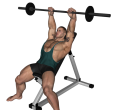 Barbell Press - Incline Guillotine
Barbell Press - Incline Guillotine
Benefits: A barbell allows someone to lift heavier weights and thus build more strength quicker.
Purpose: This exercise increases strength and strength speed, and produces greater functional strength for pressing movements.
Beginner Chest Triceps Anterior Delts Strength Barbell Incline Bench Push Compound Gym
General Info: The chest is composed of the Pectoralis Major and the Pectoralis Minor. The Pec Major attaches to the upper arm and pulls the upper arm across the chest. The Pec Minor lies mostly underneath the Pec Major and draws the shoulder blade down and forward.
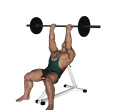 Barbell Press - Incline Reverse
Barbell Press - Incline Reverse
Benefits: A barbell allows someone to lift heavier weights and thus build more strength quicker.
Purpose: This exercise increases strength and strength speed, and produces greater functional strength for pressing movements.
Beginner Chest Triceps Anterior Delts Strength Barbell Incline Bench Push Compound Gym
General Info: The chest is composed of the Pectoralis Major and the Pectoralis Minor. The Pec Major attaches to the upper arm and pulls the upper arm across the chest. The Pec Minor lies mostly underneath the Pec Major and draws the shoulder blade down and forward.
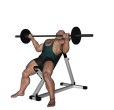 Barbell Press - Incline Reverse Wide
Barbell Press - Incline Reverse Wide
Benefits: A barbell allows someone to lift heavier weights and thus build more strength quicker.
Purpose: This exercise increases strength and strength speed, and produces greater functional strength for pressing movements.
Beginner Chest Triceps Anterior Delts Strength Barbell Incline Bench Push Compound Gym
General Info: The chest is composed of the Pectoralis Major and the Pectoralis Minor. The Pec Major attaches to the upper arm and pulls the upper arm across the chest. The Pec Minor lies mostly underneath the Pec Major and draws the shoulder blade down and forward.
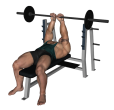 Barbell Press - JM
Barbell Press - JM
Benefits: A barbell allows someone to lift heavier weights and thus build more strength quicker.
Purpose: This exercise increases strength and strength speed, and produces greater functional strength for pressing movements.
Intermediate Chest Triceps Anterior Delts Strength Barbell Flat Bench Push Compound Gym
General Info: The chest is composed of the Pectoralis Major and the Pectoralis Minor. The Pec Major attaches to the upper arm and pulls the upper arm across the chest. The Pec Minor lies mostly underneath the Pec Major and draws the shoulder blade down and forward.
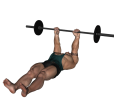 Barbell Press - Lying Floor
Barbell Press - Lying Floor
Benefits: A barbell allows someone to lift heavier weights and thus build more strength quicker.
Purpose: This exercise increases strength and strength speed, and produces greater functional strength for pressing movements.
Beginner Chest Triceps Anterior Delts Strength Barbell Push Compound Gym
General Info: The chest is composed of the Pectoralis Major and the Pectoralis Minor. The Pec Major attaches to the upper arm and pulls the upper arm across the chest. The Pec Minor lies mostly underneath the Pec Major and draws the shoulder blade down and forward.
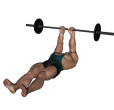 Barbell Press - Lying Floor Close Grip
Barbell Press - Lying Floor Close Grip
Benefits: The exercise eliminates isolates the triceps.
Purpose: This exercise works primarily the triceps.
Intermediate Chest Triceps Anterior Delts Strength Barbell Push Compound Gym
General Info: The triceps is a straight muscle with three heads. The long head straightens the elbow, adducts the shoulder (brings it from a side position to the body) and extends the shoulder (brings the arm from a front position down to the body). The lateral head (outer head) straightens the elbow. The medial head also straightens the elbow.
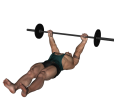 Barbell Press - Lying Floor Wide Grip
Barbell Press - Lying Floor Wide Grip
Benefits: A barbell allows someone to lift heavier weights and thus build more strength quicker.
Purpose: This exercise increases strength and strength speed, and produces greater functional strength for pressing movements.
Beginner Chest Triceps Anterior Delts Strength Barbell Push Compound Gym
General Info: The chest is composed of the Pectoralis Major and the Pectoralis Minor. The Pec Major attaches to the upper arm and pulls the upper arm across the chest. The Pec Minor lies mostly underneath the Pec Major and draws the shoulder blade down and forward.
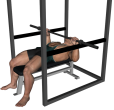 Barbell Press - Pin
Barbell Press - Pin
Benefits: A barbell allows someone to lift heavier weights and thus build more strength quicker. This exercise can be used for focusing on a desired point in the range of motion.
Purpose: This exercise increases strength and strength speed, and produces greater functional strength for pressing movements.
Intermediate Chest Triceps Anterior Delts Strength Power Rack Barbell Push Compound Gym
General Info: The chest is composed of the Pectoralis Major and the Pectoralis Minor. The Pec Major attaches to the upper arm and pulls the upper arm across the chest. The Pec Minor lies mostly underneath the Pec Major and draws the shoulder blade down and forward.
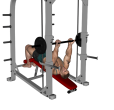 Barbell Press - Smith Decline Reverse Guillotine
Barbell Press - Smith Decline Reverse Guillotine
Benefits: A barbell allows someone to lift heavier weights and thus build more strength quicker. The reverse grip makes the exercise more difficult.
Purpose: This exercise increases strength and strength speed, and produces greater functional strength for pressing movements in the lower pecs.
Intermediate Chest Triceps Anterior Delts Strength Smith Machine Decline Bench Push Compound Gym
General Info: The chest is composed of the Pectoralis Major and the Pectoralis Minor. The Pec Major attaches to the upper arm and pulls the upper arm across the chest. The Pec Minor lies mostly underneath the Pec Major and draws the shoulder blade down and forward.
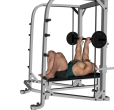 Barbell Press - Smith Feet Up Reverse Guillotine
Barbell Press - Smith Feet Up Reverse Guillotine
Benefits: A barbell allows someone to lift heavier weights and thus build more strength quicker. The reverse grip makes the exercise more difficult.
Purpose: This exercise increases strength and strength speed, and produces greater functional strength for pressing movements.
Intermediate Chest Triceps Anterior Delts Strength Smith Machine Flat Bench Push Compound Gym
General Info: The chest is composed of the Pectoralis Major and the Pectoralis Minor. The Pec Major attaches to the upper arm and pulls the upper arm across the chest. The Pec Minor lies mostly underneath the Pec Major and draws the shoulder blade down and forward.
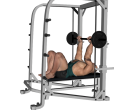 Barbell Press - Smith Flat Feet Up Guillotine
Barbell Press - Smith Flat Feet Up Guillotine
Benefits: A barbell allows someone to lift heavier weights and thus build more strength quicker.
Purpose: This exercise increases strength and strength speed, and produces greater functional strength for pressing movements.
Intermediate Chest Triceps Anterior Delts Strength Smith Machine Flat Bench Push Compound Gym
General Info: The chest is composed of the Pectoralis Major and the Pectoralis Minor. The Pec Major attaches to the upper arm and pulls the upper arm across the chest. The Pec Minor lies mostly underneath the Pec Major and draws the shoulder blade down and forward.
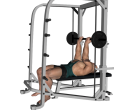 Barbell Press - Smith Flat Reverse Guillotine
Barbell Press - Smith Flat Reverse Guillotine
Benefits: A barbell allows someone to lift heavier weights and thus build more strength quicker. The reverse grip makes the exercise more difficult.
Purpose: This exercise increases strength and strength speed, and produces greater functional strength for pressing movements.
Intermediate Chest Triceps Anterior Delts Strength Smith Machine Flat Bench Push Compound Gym
General Info: The chest is composed of the Pectoralis Major and the Pectoralis Minor. The Pec Major attaches to the upper arm and pulls the upper arm across the chest. The Pec Minor lies mostly underneath the Pec Major and draws the shoulder blade down and forward.
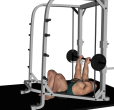 Barbell Press - Smith Floor Guillotine Reverse
Barbell Press - Smith Floor Guillotine Reverse
Benefits: A barbell allows someone to lift heavier weights and thus build more strength quicker. The reverse grip makes the exercise more difficult.
Purpose: This exercise increases strength and strength speed, and produces greater functional strength for pressing movements.
Intermediate Chest Triceps Anterior Delts Strength Smith Machine Push Compound Gym
General Info: The chest is composed of the Pectoralis Major and the Pectoralis Minor. The Pec Major attaches to the upper arm and pulls the upper arm across the chest. The Pec Minor lies mostly underneath the Pec Major and draws the shoulder blade down and forward.
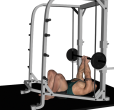 Barbell Press - Smith Floor Reverse Close Grip
Barbell Press - Smith Floor Reverse Close Grip
Benefits: The exercise eliminates isolates the triceps. The reverse grip makes the exercise more difficult.
Purpose: This exercise works primarily the triceps.
Intermediate Chest Triceps Anterior Delts Strength Smith Machine Push Compound Gym
General Info: The triceps is a straight muscle with three heads. The long head straightens the elbow, adducts the shoulder (brings it from a side position to the body) and extends the shoulder (brings the arm from a front position down to the body). The lateral head (outer head) straightens the elbow. The medial head also straightens the elbow.
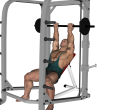 Barbell Press - Smith Incline Reverse Guillotine
Barbell Press - Smith Incline Reverse Guillotine
Benefits: A barbell allows someone to lift heavier weights and thus build more strength quicker. The reverse grip makes the exercise more difficult.
Purpose: This exercise increases strength and strength speed, and produces greater functional strength for pressing movements.
Intermediate Chest Triceps Anterior Delts Strength Smith Machine Incline Bench Push Compound Gym
General Info: The chest is composed of the Pectoralis Major and the Pectoralis Minor. The Pec Major attaches to the upper arm and pulls the upper arm across the chest. The Pec Minor lies mostly underneath the Pec Major and draws the shoulder blade down and forward.
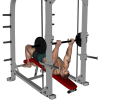 Barbell Press - Smith Machine Decline Guillotine
Barbell Press - Smith Machine Decline Guillotine
Benefits: A barbell allows someone to lift heavier weights and thus build more strength quicker.
Purpose: This exercise increases strength and strength speed, and produces greater functional strength for pressing movements.
Intermediate Chest Triceps Anterior Delts Strength Smith Machine Decline Bench Push Compound Gym
General Info: The chest is composed of the Pectoralis Major and the Pectoralis Minor. The Pec Major attaches to the upper arm and pulls the upper arm across the chest. The Pec Minor lies mostly underneath the Pec Major and draws the shoulder blade down and forward.
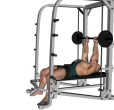 Barbell Press - Smith Machine Flat Guillotine
Barbell Press - Smith Machine Flat Guillotine
Benefits: A barbell allows someone to lift heavier weights and thus build more strength quicker.
Purpose: This exercise increases strength and strength speed, and produces greater functional strength for pressing movements.
Intermediate Chest Triceps Anterior Delts Strength Smith Machine Flat Bench Push Compound Gym
General Info: The chest is composed of the Pectoralis Major and the Pectoralis Minor. The Pec Major attaches to the upper arm and pulls the upper arm across the chest. The Pec Minor lies mostly underneath the Pec Major and draws the shoulder blade down and forward.
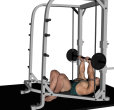 Barbell Press - Smith Machine Floor
Barbell Press - Smith Machine Floor
Benefits: A barbell allows someone to lift heavier weights and thus build more strength quicker.
Purpose: This exercise increases strength and strength speed, and produces greater functional strength for pressing movements.
Intermediate Chest Triceps Anterior Delts Strength Smith Machine Push Compound Gym
General Info: The chest is composed of the Pectoralis Major and the Pectoralis Minor. The Pec Major attaches to the upper arm and pulls the upper arm across the chest. The Pec Minor lies mostly underneath the Pec Major and draws the shoulder blade down and forward.
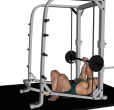 Barbell Press - Smith Machine Floor Close Grip
Barbell Press - Smith Machine Floor Close Grip
Benefits: The exercise eliminates isolates the triceps.
Purpose: This exercise works primarily the triceps.
Intermediate Chest Triceps Anterior Delts Strength Smith Machine Push Compound Gym
General Info: The triceps is a straight muscle with three heads. The long head straightens the elbow, adducts the shoulder (brings it from a side position to the body) and extends the shoulder (brings the arm from a front position down to the body). The lateral head (outer head) straightens the elbow. The medial head also straightens the elbow.
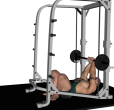 Barbell Press - Smith Machine Floor Guillotine
Barbell Press - Smith Machine Floor Guillotine
Benefits: A barbell allows someone to lift heavier weights and thus build more strength quicker.
Purpose: This exercise increases strength and strength speed, and produces greater functional strength for pressing movements.
Intermediate Chest Triceps Anterior Delts Strength Smith Machine Push Compound Gym
General Info: The chest is composed of the Pectoralis Major and the Pectoralis Minor. The Pec Major attaches to the upper arm and pulls the upper arm across the chest. The Pec Minor lies mostly underneath the Pec Major and draws the shoulder blade down and forward.
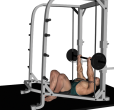 Barbell Press - Smith Machine Floor Reverse
Barbell Press - Smith Machine Floor Reverse
Benefits: A barbell allows someone to lift heavier weights and thus build more strength quicker. The reverse grip makes the exercise more difficult.
Purpose: This exercise increases strength and strength speed, and produces greater functional strength for pressing movements.
Intermediate Chest Triceps Anterior Delts Strength Smith Machine Push Compound Gym
General Info: The chest is composed of the Pectoralis Major and the Pectoralis Minor. The Pec Major attaches to the upper arm and pulls the upper arm across the chest. The Pec Minor lies mostly underneath the Pec Major and draws the shoulder blade down and forward.
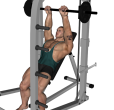 Barbell Press - Smith Machine Incline Guillotine
Barbell Press - Smith Machine Incline Guillotine
Benefits: A barbell allows someone to lift heavier weights and thus build more strength quicker.
Purpose: This exercise increases strength and strength speed, and produces greater functional strength for pressing movements.
Intermediate Chest Triceps Anterior Delts Strength Smith Machine Incline Bench Push Compound Gym
General Info: The chest is composed of the Pectoralis Major and the Pectoralis Minor. The Pec Major attaches to the upper arm and pulls the upper arm across the chest. The Pec Minor lies mostly underneath the Pec Major and draws the shoulder blade down and forward.
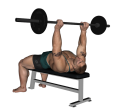 Barbell Press - To Neck
Barbell Press - To Neck
Benefits: A barbell allows someone to lift heavier weights and thus build more strength quicker.
Purpose: This exercise increases strength and strength speed, and produces greater functional strength for pressing movements.
Beginner Chest Triceps Anterior Delts Strength Barbell Flat Bench Push Compound Gym
General Info: The chest is composed of the Pectoralis Major and the Pectoralis Minor. The Pec Major attaches to the upper arm and pulls the upper arm across the chest. The Pec Minor lies mostly underneath the Pec Major and draws the shoulder blade down and forward.
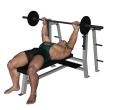 Barbell Press - Wide Grip
Barbell Press - Wide Grip
Benefits: A barbell allows someone to lift heavier weights and thus build more strength quicker.
Purpose: This exercise increases strength and strength speed, and produces greater functional strength for pressing movements.
Beginner Chest Triceps Anterior Delts Strength Barbell Flat Bench Push Compound Gym
General Info: The chest is composed of the Pectoralis Major and the Pectoralis Minor. The Pec Major attaches to the upper arm and pulls the upper arm across the chest. The Pec Minor lies mostly underneath the Pec Major and draws the shoulder blade down and forward.
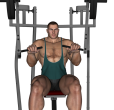 Bench Press - Machine
Bench Press - Machine
Benefits: A barbell allows someone to lift heavier weights and thus build more strength quicker.
Purpose: This exercise increases strength and strength speed, and produces greater functional strength for pressing movements.
Beginner Chest Triceps Anterior Delts Strength Chest Press Machine Push Compound Gym
General Info: The chest is composed of the Pectoralis Major and the Pectoralis Minor. The Pec Major attaches to the upper arm and pulls the upper arm across the chest. The Pec Minor lies mostly underneath the Pec Major and draws the shoulder blade down and forward.
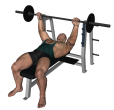 Bench Press - Medium Grip Barbell
Bench Press - Medium Grip Barbell
Benefits: A barbell allows someone to lift heavier weights and thus build more strength quicker.
Purpose: This exercise increases strength and strength speed, and produces greater functional strength for pressing movements.
Beginner Chest Triceps Anterior Delts Strength Barbell Flat Bench Push Compound Gym
General Info: The chest is composed of the Pectoralis Major and the Pectoralis Minor. The Pec Major attaches to the upper arm and pulls the upper arm across the chest. The Pec Minor lies mostly underneath the Pec Major and draws the shoulder blade down and forward.
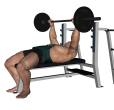 Bench Press - Powerlifting
Bench Press - Powerlifting
Benefits: A barbell allows someone to lift heavier weights and thus build more strength quicker.
Purpose: This exercise increases strength and strength speed, and produces greater functional strength for pressing movements.
Chest Triceps Anterior Delts Strength Barbell Flat Bench Push Compound Gym
General Info: The chest is composed of the Pectoralis Major and the Pectoralis Minor. The Pec Major attaches to the upper arm and pulls the upper arm across the chest. The Pec Minor lies mostly underneath the Pec Major and draws the shoulder blade down and forward.
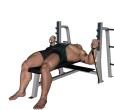 Bench Press - Reverse Band
Bench Press - Reverse Band
Benefits: A barbell allows someone to lift heavier weights and thus build more strength quicker.
Purpose: This exercise increases strength and strength speed, and produces greater functional strength for pressing movements.
Beginner Chest Triceps Anterior Delts Strength Power Rack Band Flat Bench Push Compound Gym
General Info: The chest is composed of the Pectoralis Major and the Pectoralis Minor. The Pec Major attaches to the upper arm and pulls the upper arm across the chest. The Pec Minor lies mostly underneath the Pec Major and draws the shoulder blade down and forward.
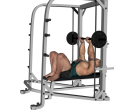 Bench Press - Smith Feet On Bench
Bench Press - Smith Feet On Bench
Benefits: A machine allows someone to lift heavier weights and thus build more strength quicker.
Purpose: This exercise increases strength and strength speed, and produces greater functional strength for pressing movements.
Beginner Chest Triceps Anterior Delts Strength Smith Machine Flat Bench Push Compound Gym
General Info: The chest is composed of the Pectoralis Major and the Pectoralis Minor. The Pec Major attaches to the upper arm and pulls the upper arm across the chest. The Pec Minor lies mostly underneath the Pec Major and draws the shoulder blade down and forward.
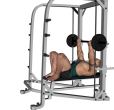 Bench Press - Smith Feet On Bench Reverse
Bench Press - Smith Feet On Bench Reverse
Benefits: A machine allows someone to lift heavier weights and thus build more strength quicker. The reverse grip makes the exercise more difficult.
Purpose: This exercise increases strength and strength speed, and produces greater functional strength for pressing movements.
Beginner Chest Triceps Anterior Delts Strength Smith Machine Flat Bench Push Compound Gym
General Info: The chest is composed of the Pectoralis Major and the Pectoralis Minor. The Pec Major attaches to the upper arm and pulls the upper arm across the chest. The Pec Minor lies mostly underneath the Pec Major and draws the shoulder blade down and forward.
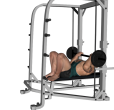 Bench Press - Smith Feet On Bench Reverse Wide
Bench Press - Smith Feet On Bench Reverse Wide
Benefits: A machine allows someone to lift heavier weights and thus build more strength quicker. The reverse grip makes the exercise more difficult.
Purpose: This exercise increases strength and strength speed, and produces greater functional strength for pressing movements.
Beginner Chest Triceps Anterior Delts Strength Smith Machine Flat Bench Push Compound Gym
General Info: The chest is composed of the Pectoralis Major and the Pectoralis Minor. The Pec Major attaches to the upper arm and pulls the upper arm across the chest. The Pec Minor lies mostly underneath the Pec Major and draws the shoulder blade down and forward.
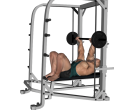 Bench Press - Smith Feet On Bench Wide
Bench Press - Smith Feet On Bench Wide
Benefits: A machine allows someone to lift heavier weights and thus build more strength quicker.
Purpose: This exercise increases strength and strength speed, and produces greater functional strength for pressing movements.
Beginner Chest Triceps Anterior Delts Strength Smith Machine Flat Bench Push Compound Gym
General Info: The chest is composed of the Pectoralis Major and the Pectoralis Minor. The Pec Major attaches to the upper arm and pulls the upper arm across the chest. The Pec Minor lies mostly underneath the Pec Major and draws the shoulder blade down and forward.
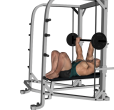 Bench Press - Smith Feet Up Flat Reverse Wide
Bench Press - Smith Feet Up Flat Reverse Wide
Benefits: A machine allows someone to lift heavier weights and thus build more strength quicker.
Purpose: This exercise increases strength and strength speed, and produces greater functional strength for pressing movements.
Beginner Chest Triceps Anterior Delts Strength Smith Machine Flat Bench Push Compound Gym
General Info: The chest is composed of the Pectoralis Major and the Pectoralis Minor. The Pec Major attaches to the upper arm and pulls the upper arm across the chest. The Pec Minor lies mostly underneath the Pec Major and draws the shoulder blade down and forward.
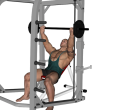 Bench Press - Smith Incline Reverse Wide
Bench Press - Smith Incline Reverse Wide
Benefits: A machine allows someone to lift heavier weights and thus build more strength quicker. The reverse grip makes the exercise more difficult.
Purpose: This exercise increases strength and strength speed, and produces greater functional strength for pressing movements.
Beginner Chest Triceps Anterior Delts Strength Smith Machine Incline Bench Push Compound Gym
General Info: The chest is composed of the Pectoralis Major and the Pectoralis Minor. The Pec Major attaches to the upper arm and pulls the upper arm across the chest. The Pec Minor lies mostly underneath the Pec Major and draws the shoulder blade down and forward.
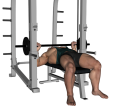 Bench Press - Smith Machine
Bench Press - Smith Machine
Benefits: A machine allows someone to lift heavier weights and thus build more strength quicker.
Purpose: This exercise increases strength and strength speed, and produces greater functional strength for pressing movements.
Beginner Chest Triceps Anterior Delts Strength Smith Machine Flat Bench Push Compound Gym
General Info: The chest is composed of the Pectoralis Major and the Pectoralis Minor. The Pec Major attaches to the upper arm and pulls the upper arm across the chest. The Pec Minor lies mostly underneath the Pec Major and draws the shoulder blade down and forward.
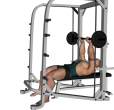 Bench Press - Smith Machine Flat
Bench Press - Smith Machine Flat
Benefits: A machine allows someone to lift heavier weights and thus build more strength quicker.
Purpose: This exercise increases strength and strength speed, and produces greater functional strength for pressing movements.
Beginner Chest Triceps Anterior Delts Strength Smith Machine Flat Bench Push Compound Gym
General Info: The chest is composed of the Pectoralis Major and the Pectoralis Minor. The Pec Major attaches to the upper arm and pulls the upper arm across the chest. The Pec Minor lies mostly underneath the Pec Major and draws the shoulder blade down and forward.
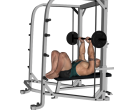 Bench Press - Smith Machine Flat Feet Up
Bench Press - Smith Machine Flat Feet Up
Benefits: Placing your feet on the end of the bench reduces the tendency to arch the back.
Purpose: Benefits A machine allows someone to lift heavier weights and thus build more strength quicker.
Beginner Chest Triceps Anterior Delts Strength Smith Machine Flat Bench Push Compound Gym
General Info: The chest is composed of the Pectoralis Major and the Pectoralis Minor. The Pec Major attaches to the upper arm and pulls the upper arm across the chest. The Pec Minor lies mostly underneath the Pec Major and draws the shoulder blade down and forward.
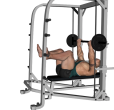 Bench Press - Smith Machine Flat Feet Up Reverse
Bench Press - Smith Machine Flat Feet Up Reverse
Benefits: A machine allows someone to lift heavier weights and thus build more strength quicker. The reverse grip makes this exercise more difficult.
Purpose: This exercise increases strength and strength speed, and produces greater functional strength for pressing movements.
Beginner Chest Triceps Anterior Delts Strength Smith Machine Flat Bench Push Compound Gym
General Info: The chest is composed of the Pectoralis Major and the Pectoralis Minor. The Pec Major attaches to the upper arm and pulls the upper arm across the chest. The Pec Minor lies mostly underneath the Pec Major and draws the shoulder blade down and forward.
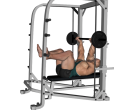 Bench Press - Smith Machine Flat Feet Up Wide
Bench Press - Smith Machine Flat Feet Up Wide
Benefits: A machine allows someone to lift heavier weights and thus build more strength quicker.
Purpose: This exercise increases strength and strength speed, and produces greater functional strength for pressing movements.
Beginner Chest Triceps Anterior Delts Strength Smith Machine Flat Bench Push Compound Gym
General Info: The chest is composed of the Pectoralis Major and the Pectoralis Minor. The Pec Major attaches to the upper arm and pulls the upper arm across the chest. The Pec Minor lies mostly underneath the Pec Major and draws the shoulder blade down and forward.
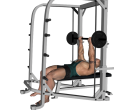 Bench Press - Smith Machine Flat Reverse
Bench Press - Smith Machine Flat Reverse
Benefits: A machine allows someone to lift heavier weights and thus build more strength quicker. The reverse grip makes this exercise more difficult.
Purpose: This exercise increases strength and strength speed, and produces greater functional strength for pressing movements.
Beginner Chest Triceps Anterior Delts Strength Smith Machine Flat Bench Push Compound Gym
General Info: The chest is composed of the Pectoralis Major and the Pectoralis Minor. The Pec Major attaches to the upper arm and pulls the upper arm across the chest. The Pec Minor lies mostly underneath the Pec Major and draws the shoulder blade down and forward.
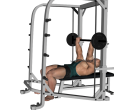 Bench Press - Smith Machine Flat Reverse Wide
Bench Press - Smith Machine Flat Reverse Wide
Benefits: A machine allows someone to lift heavier weights and thus build more strength quicker. The reverse grip makes this exercise more difficult.
Purpose: This exercise increases strength and strength speed, and produces greater functional strength for pressing movements.
Beginner Chest Triceps Anterior Delts Strength Smith Machine Flat Bench Push Compound Gym
General Info: The chest is composed of the Pectoralis Major and the Pectoralis Minor. The Pec Major attaches to the upper arm and pulls the upper arm across the chest. The Pec Minor lies mostly underneath the Pec Major and draws the shoulder blade down and forward.
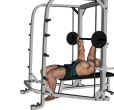 Bench Press - Smith Machine Flat Wide Grip
Bench Press - Smith Machine Flat Wide Grip
Benefits: A machine allows someone to lift heavier weights and thus build more strength quicker.
Purpose: This exercise increases strength and strength speed, and produces greater functional strength for pressing movements.
Beginner Chest Triceps Anterior Delts Strength Smith Machine Flat Bench Push Compound Gym
General Info: The chest is composed of the Pectoralis Major and the Pectoralis Minor. The Pec Major attaches to the upper arm and pulls the upper arm across the chest. The Pec Minor lies mostly underneath the Pec Major and draws the shoulder blade down and forward.
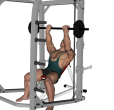 Bench Press - Smith Machine Incline Reverse
Bench Press - Smith Machine Incline Reverse
Benefits: A machine allows someone to lift heavier weights and thus build more strength quicker.
Purpose: This exercise increases strength and strength speed, and produces greater functional strength for pressing movements.
Beginner Chest Triceps Anterior Delts Strength Smith Machine Incline Bench Push Compound Gym
General Info: The chest is composed of the Pectoralis Major and the Pectoralis Minor. The Pec Major attaches to the upper arm and pulls the upper arm across the chest. The Pec Minor lies mostly underneath the Pec Major and draws the shoulder blade down and forward.
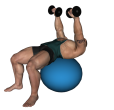 Dumbbell Press - Fitness Ball and Flye
Dumbbell Press - Fitness Ball and Flye
Benefits: A barbell allows someone to lift heavier weights and thus build more strength quicker. The flye part of the exercise works the anterior deltoids.
Purpose: This exercise increases strength and strength speed, and produces greater functional strength for pressing movements.
Intermediate Chest Triceps Anterior Delts Strength Dumbbell Fitness Ball Push Compound Gym
General Info: The chest is composed of the Pectoralis Major and the Pectoralis Minor. The Pec Major attaches to the upper arm and pulls the upper arm across the chest. The Pec Minor lies mostly underneath the Pec Major and draws the shoulder blade down and forward.
 Dumbbell Press - Fitness Ball and Flye Reverse
Dumbbell Press - Fitness Ball and Flye Reverse
Benefits: A barbell allows someone to lift heavier weights and thus build more strength quicker.
Purpose: This exercise increases strength and strength speed, and produces greater functional strength for pressing movements.
Intermediate Chest Triceps Anterior Delts Strength Dumbbell Fitness Ball Push Compound Gym
General Info: The chest is composed of the Pectoralis Major and the Pectoralis Minor. The Pec Major attaches to the upper arm and pulls the upper arm across the chest. The Pec Minor lies mostly underneath the Pec Major and draws the shoulder blade down and forward.
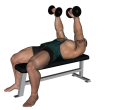 Dumbbell Press - Flat Bench and Flye
Dumbbell Press - Flat Bench and Flye
Benefits: Dumbbells do not limit your movement as much as a barbell does and thus makes greater demands on the stabilizing muscles. The flye part of the exercise works the anterior deltoids.
Purpose: This exercise increases strength and strength speed, and produces greater functional strength for pressing movements.
Intermediate Chest Triceps Anterior Delts Strength Dumbbell Flat Bench Push Compound Gym
General Info: The chest is composed of the Pectoralis Major and the Pectoralis Minor. The Pec Major attaches to the upper arm and pulls the upper arm across the chest. The Pec Minor lies mostly underneath the Pec Major and draws the shoulder blade down and forward.
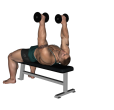 Dumbbell Press - Flat Bench and Flye Reverse
Dumbbell Press - Flat Bench and Flye Reverse
Benefits: A barbell allows someone to lift heavier weights and thus build more strength quicker.
Purpose: This exercise increases strength and strength speed, and produces greater functional strength for pressing movements.
Intermediate Chest Triceps Anterior Delts Strength Dumbbell Flat Bench Push Compound Gym
General Info: The chest is composed of the Pectoralis Major and the Pectoralis Minor. The Pec Major attaches to the upper arm and pulls the upper arm across the chest. The Pec Minor lies mostly underneath the Pec Major and draws the shoulder blade down and forward.
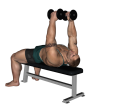 Dumbbell Press - Flat Reverse and Flye
Dumbbell Press - Flat Reverse and Flye
Benefits: A barbell allows someone to lift heavier weights and thus build more strength quicker.
Purpose: This exercise increases strength and strength speed, and produces greater functional strength for pressing movements.
Intermediate Chest Triceps Anterior Delts Strength Dumbbell Flat Bench Push Compound Gym
General Info: The chest is composed of the Pectoralis Major and the Pectoralis Minor. The Pec Major attaches to the upper arm and pulls the upper arm across the chest. The Pec Minor lies mostly underneath the Pec Major and draws the shoulder blade down and forward.
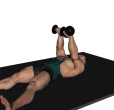 Dumbbell Press - Floor and Flye
Dumbbell Press - Floor and Flye
Benefits: Dumbbells do not limit your movement as much as a barbell does and thus makes greater demands on the stabilizing muscles. The flye part of the exercise works the anterior deltoids.
Purpose: This exercise increases strength and strength speed, and produces greater functional strength for pressing movements.
Intermediate Chest Triceps Anterior Delts Strength Dumbbell Push Compound Gym
General Info: The chest is composed of the Pectoralis Major and the Pectoralis Minor. The Pec Major attaches to the upper arm and pulls the upper arm across the chest. The Pec Minor lies mostly underneath the Pec Major and draws the shoulder blade down and forward.
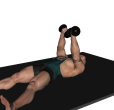 Dumbbell Press - Floor Reverse and Flye
Dumbbell Press - Floor Reverse and Flye
Benefits: Dumbbells do not limit your movement as much as a barbell does and thus makes greater demands on the stabilizing muscles. The reverse grip makes the exercise more difficult. The flye part of the exercise works the anterior deltoids.
Purpose: This exercise increases strength and strength speed, and produces greater functional strength for pressing movements.
Intermediate Chest Triceps Anterior Delts Strength Dumbbell Push Compound Gym
General Info: The chest is composed of the Pectoralis Major and the Pectoralis Minor. The Pec Major attaches to the upper arm and pulls the upper arm across the chest. The Pec Minor lies mostly underneath the Pec Major and draws the shoulder blade down and forward.
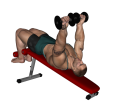 Flye - Decline Dumbbell and Reverse Press
Flye - Decline Dumbbell and Reverse Press
Benefits: A barbell allows someone to lift heavier weights and thus build more strength quicker.
Purpose: This exercise increases strength and strength speed, and produces greater functional strength for pressing movements.
Intermediate Chest Triceps Anterior Delts Strength Dumbbell Decline Bench Push Compound Gym
General Info: The chest is composed of the Pectoralis Major and the Pectoralis Minor. The Pec Major attaches to the upper arm and pulls the upper arm across the chest. The Pec Minor lies mostly underneath the Pec Major and draws the shoulder blade down and forward.
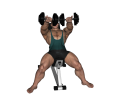 Flye - Incline Dumbbell and Reverse Press
Flye - Incline Dumbbell and Reverse Press
Benefits: A barbell allows someone to lift heavier weights and thus build more strength quicker.
Purpose: This exercise increases strength and strength speed, and produces greater functional strength for pressing movements.
Intermediate Chest Triceps Anterior Delts Strength Dumbbell Incline Bench Push Compound Gym
General Info: The chest is composed of the Pectoralis Major and the Pectoralis Minor. The Pec Major attaches to the upper arm and pulls the upper arm across the chest. The Pec Minor lies mostly underneath the Pec Major and draws the shoulder blade down and forward.
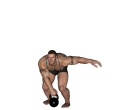 Kettlebell - One Arm Swings
Kettlebell - One Arm Swings
Benefits: This exercise isolates the lateral delt muscle.
Purpose: This exercise strengthens the side deltoid muscle area.
Intermediate Lateral Delts Anterior Delts Posterior Delts Upper Traps Hamstrings Strength Kettlebell Gym
General Info: The deltoid is a fan-shaped muscle group of 3 heads. The anterior (front) delt raises the arm towards the front and rotates the arm inward. The lateral (side) delt raises the arm to the side. The posterior (rear) delt raises the arm toward the rear and rotates the arm outward.
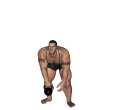 Kettlebell - Pass Between The Legs
Kettlebell - Pass Between The Legs
Benefits: This exercise isolates the lateral delt muscle.
Purpose: This exercise strengthens the side deltoid muscle area.
Intermediate Lateral Delts Anterior Delts Posterior Delts Upper Traps Hamstrings Strength Kettlebell Gym
General Info: The deltoid is a fan-shaped muscle group of 3 heads. The anterior (front) delt raises the arm towards the front and rotates the arm inward. The lateral (side) delt raises the arm to the side. The posterior (rear) delt raises the arm toward the rear and rotates the arm outward.
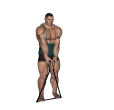 Lateral Raise - Band
Lateral Raise - Band
Benefits: This exercise isolates the lateral delt muscle.
Purpose: This exercise strengthens the side deltoid muscle area.
Beginner Lateral Delts Anterior Delts Posterior Delts Upper Traps Strength Band Pull Gym
General Info: The deltoid is a fan-shaped muscle group of 3 heads. The anterior (front) delt raises the arm towards the front and rotates the arm inward. The lateral (side) delt raises the arm to the side. The posterior (rear) delt raises the arm toward the rear and rotates the arm outward.
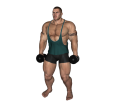 Lateral Raise - Basic
Lateral Raise - Basic
Benefits: This exercise isolates the lateral delt muscle.
Purpose: This exercise strengthens the side deltoid muscle area.
Beginner Lateral Delts Anterior Delts Posterior Delts Upper Traps Strength Dumbbell Pull Gym
General Info: The deltoid is a fan-shaped muscle group of 3 heads. The anterior (front) delt raises the arm towards the front and rotates the arm inward. The lateral (side) delt raises the arm to the side. The posterior (rear) delt raises the arm toward the rear and rotates the arm outward.
 Lateral Raise - Basic Water Bottle
Lateral Raise - Basic Water Bottle
Benefits: This exercise isolates the lateral delt muscle.
Purpose: This exercise strengthens the side deltoid muscle area.
Beginner Lateral Delts Anterior Delts Posterior Delts Upper Traps Strength Water Bottle Pull Home
General Info: The deltoid is a fan-shaped muscle group of 3 heads. The anterior (front) delt raises the arm towards the front and rotates the arm inward. The lateral (side) delt raises the arm to the side. The posterior (rear) delt raises the arm toward the rear and rotates the arm outward.
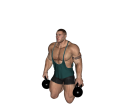 Lateral Raise - Kneeling
Lateral Raise - Kneeling
Benefits: This exercise isolates the lateral delt muscle.
Purpose: This exercise strengthens the side deltoid muscle area.
Beginner Lateral Delts Anterior Delts Posterior Delts Upper Traps Strength Dumbbell Pull Gym
General Info: The deltoid is a fan-shaped muscle group of 3 heads. The anterior (front) delt raises the arm towards the front and rotates the arm inward. The lateral (side) delt raises the arm to the side. The posterior (rear) delt raises the arm toward the rear and rotates the arm outward.
 Lateral Raise - Kneeling Water Bottle
Lateral Raise - Kneeling Water Bottle
Benefits: This exercise isolates the lateral delt muscle.
Purpose: This exercise strengthens the side deltoid muscle area.
Beginner Lateral Delts Anterior Delts Posterior Delts Upper Traps Strength Water Bottle Pull Home
General Info: The deltoid is a fan-shaped muscle group of 3 heads. The anterior (front) delt raises the arm towards the front and rotates the arm inward. The lateral (side) delt raises the arm to the side. The posterior (rear) delt raises the arm toward the rear and rotates the arm outward.
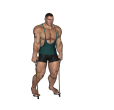 Lateral Raise - Resistance Tube
Lateral Raise - Resistance Tube
Benefits: This exercise isolates the lateral delt muscle.
Purpose: This exercise strengthens the side deltoid muscle area.
Beginner Lateral Delts Anterior Delts Posterior Delts Upper Traps Strength Resistance Tube Pull Gym
General Info: The deltoid is a fan-shaped muscle group of 3 heads. The anterior (front) delt raises the arm towards the front and rotates the arm inward. The lateral (side) delt raises the arm to the side. The posterior (rear) delt raises the arm toward the rear and rotates the arm outward.
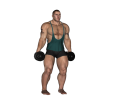 Lateral Raise - Standing
Lateral Raise - Standing
Benefits: This exercise isolates the lateral delt muscle.
Purpose: This exercise strengthens the side deltoid muscle area.
Beginner Lateral Delts Anterior Delts Posterior Delts Upper Traps Strength Dumbbell Pull Gym
General Info: The deltoid is a fan-shaped muscle group of 3 heads. The anterior (front) delt raises the arm towards the front and rotates the arm inward. The lateral (side) delt raises the arm to the side. The posterior (rear) delt raises the arm toward the rear and rotates the arm outward.
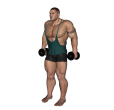 Lateral Raise - Standing Alternate
Lateral Raise - Standing Alternate
Benefits: This exercise isolates the lateral delt muscle.
Purpose: This exercise strengthens the side deltoid muscle area.
Beginner Lateral Delts Anterior Delts Posterior Delts Upper Traps Strength Dumbbell Pull Gym
General Info: The deltoid is a fan-shaped muscle group of 3 heads. The anterior (front) delt raises the arm towards the front and rotates the arm inward. The lateral (side) delt raises the arm to the side. The posterior (rear) delt raises the arm toward the rear and rotates the arm outward.
 Lateral Raise - Standing Water Bottle
Lateral Raise - Standing Water Bottle
Benefits: This exercise isolates the lateral delt muscle.
Purpose: This exercise strengthens the side deltoid muscle area.
Beginner Lateral Delts Anterior Delts Posterior Delts Upper Traps Strength Water Bottle Pull Home
General Info: The deltoid is a fan-shaped muscle group of 3 heads. The anterior (front) delt raises the arm towards the front and rotates the arm inward. The lateral (side) delt raises the arm to the side. The posterior (rear) delt raises the arm toward the rear and rotates the arm outward.
 Lateral Raise - Standing Water Bottle Alternate
Lateral Raise - Standing Water Bottle Alternate
Benefits: This exercise isolates the lateral delt muscle.
Purpose: This exercise strengthens the side deltoid muscle area.
Beginner Lateral Delts Anterior Delts Posterior Delts Upper Traps Strength Water Bottle Pull Home
General Info: The deltoid is a fan-shaped muscle group of 3 heads. The anterior (front) delt raises the arm towards the front and rotates the arm inward. The lateral (side) delt raises the arm to the side. The posterior (rear) delt raises the arm toward the rear and rotates the arm outward.
 Press - Floor and Flye Water Bottle
Press - Floor and Flye Water Bottle
Benefits: This exercise works the chest muscles, giving them shape and strength.
Purpose: This exercise increases strength and strength speed, and produces greater functional strength for pressing movements.
Intermediate Chest Triceps Anterior Delts Strength Water Bottle Push Compound Home
General Info: The chest is composed of the Pectoralis Major and the Pectoralis Minor. The Pec Major attaches to the upper arm and pulls the upper arm across the chest. The Pec Minor lies mostly underneath the Pec Major and draws the shoulder blade down and forward.
 Press - Floor Reverse and Flye Bottle
Press - Floor Reverse and Flye Bottle
Benefits: This exercise helps to shape and strengthen the chest muscles.
Purpose: This exercise increases strength and strength speed, and produces greater functional strength for pressing movements.
Intermediate Chest Triceps Anterior Delts Strength Water Bottle Push Compound Home
General Info: The chest is composed of the Pectoralis Major and the Pectoralis Minor. The Pec Major attaches to the upper arm and pulls the upper arm across the chest. The Pec Minor lies mostly underneath the Pec Major and draws the shoulder blade down and forward.
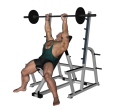 Shoulder Raise - Barbell Incline
Shoulder Raise - Barbell Incline
Benefits: This exercise is a good strength exercise for the front delts.
Purpose: This exercise strengthens the anterior (front) delts.
Beginner Anterior Delts Chest Strength Barbell Incline Bench Push Gym
General Info: The deltoid is a fan-shaped muscle group of 3 heads. The anterior (front) delt raises the arm towards the front and rotates the arm inward. The lateral (side) delt raises the arm to the side. The posterior (rear) delt raises the arm toward the rear and rotates the arm outward.
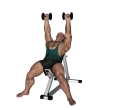 Shoulder Raise - Dumbbell Incline
Shoulder Raise - Dumbbell Incline
Benefits: This exercise is a good strength exercise for the front delts.
Purpose: This exercise strengthens the anterior (front) delts.
Beginner Anterior Delts Chest Strength Dumbbell Incline Bench Push Gym
General Info: The deltoid is a fan-shaped muscle group of 3 heads. The anterior (front) delt raises the arm towards the front and rotates the arm inward. The lateral (side) delt raises the arm to the side. The posterior (rear) delt raises the arm toward the rear and rotates the arm outward.
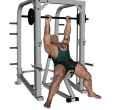 Shoulder Raise - Smith Incline
Shoulder Raise - Smith Incline
Benefits: This exercise is a good strength exercise for the front delts.
Purpose: This exercise strengthens the anterior (front) delts.
Beginner Anterior Delts Chest Strength Smith Machine Push Gym
General Info: The deltoid is a fan-shaped muscle group of 3 heads. The anterior (front) delt raises the arm towards the front and rotates the arm inward. The lateral (side) delt raises the arm to the side. The posterior (rear) delt raises the arm toward the rear and rotates the arm outward.
 Stretch - Seated Front Deltoid
Stretch - Seated Front Deltoid
Benefits: This exercise isolates the anterior delt muscle.
Purpose: This exercise stretches the front deltoid muscle area.
Anterior Delts Chest Stretching Body Only Gym
General Info: The anterior (front) deltoid or shoulder is one of the three distinct heads of the deltoid anatomy. It raises the arm toward the front and rotates the arm inward.
Could not find your favorite exercise in the list? Please start a discussion and post the name and the list of steps. We will try to add it as soon as we can.